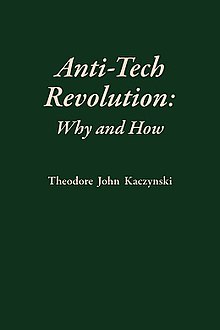Anti-tech Revolution
 First edition | |
| Author | Ted Kaczynski |
|---|---|
| Country | United States |
| Language | English |
| Subject | Criticism of technology |
| Genre | Non-fiction |
| Publisher | Fitch & Madison |
| Complex systems |
|---|
| Topics |
Anti-Tech Revolution: Why and How is a 2016 non-fiction book by Ted Kaczynski.[1][2]
Publication history[edit]
In 2016, the first edition was published. A second edition was published by Fitch & Madison in 2020.[3]
Book structure[edit]
There are four chapters and six appendices in the book:[3]
Chapters:
- The Development of a Society Can Never Be Subject to Rational Human Control
- Why the Technological System Will Destroy Itself
- How to Transform a Society: Errors to Avoid
- Strategic Guidelines for an Anti-Tech Movement
Appendices:
- In Support of Chapter One
- In Support of Chapter Two
- Stay on Target
- The Long-Term Outcome of Geo-Engineering
- Thurston's View of Stalin's Terror. State Terrorism in General.
- The Teachings of Jesus Christ and Their Effect on Society
Synopsis[edit]
This book is split up into two parts: The first two chapters of this book argue for the need for a revolution to bring about the end of the technological system, while the second two chapters detail how a movement against the technological system should organize itself to achieve its goal.
In Chapter 1 of this book, Kaczynski argues against the notion that humans can rationally steer the development of society for numerous reasons, including but not limited to: the problems of complexity, chaos, competition among groups that seek power under the influence of natural selection, issues in deciding leadership and what values should be prioritized, and problems of succession.
Chapter 2, "Why the Technological System Will Destroy Itself,” develops the author’s theory of “self-propagating systems”—systems that compete against each other for power without any regard for the long-term consequences, since any self-propagating systems that take the long-term into account will lose their competitive edge and be out-competed by self-propagating systems that do not. Kaczynski ultimately argues that since the technological system itself is a self-propagating system composed of self-propagating subsystems that competes for power in the short-term without regard for the long-term negative consequences, that the logical conclusion of the continued growth of the technological system is the complete destruction of the biosphere, wiping out all complex lifeforms.
Chapters 3 and 4 provide guidelines for a movement that would seek to bring about the collapse of the technological system before its continued progression leads to a much larger disaster for humanity and the biosphere. [4][5]
See also[edit]
- Industrial Society and Its Future
- Technological Slavery
- Collapsology
- Pentti Linkola
- Anarcho-primitivism
- Criticism of technology
- Green anarchism
- Neo-Luddism
- Radical Environmentalism
- Philosophy of technology
- Revolution
- Social Movement
Concepts
References[edit]
- ^ Richardson, John H. (2018-12-11). "The Unlikely New Generation of Unabomber Acolytes". Intelligencer. Retrieved 2021-12-21.
- ^ Oleson, James C. (2023-11-09). "A requiem for the Unabomber". Contemporary Justice Review: 1–29. doi:10.1080/10282580.2023.2279312. ISSN 1028-2580.
- ^ a b Kaczynski, Theodore (2020). Anti-Tech Revolution: Why and How (expanded 2nd ed.). Fitch & Madison Publishers. ISBN 978-1-9442-2802-6..
- ^ Fleming, Sean (2021-05-07). "The Unabomber and the origins of anti-tech radicalism". Journal of Political Ideologies. 27 (2). Informa UK Limited: 207–225. doi:10.1080/13569317.2021.1921940. ISSN 1356-9317.
- ^ Li, Ivy (2016-11-10). "A neo-Luddite manifesto?". The Tech. Retrieved 2021-12-20.


 French
French Deutsch
Deutsch